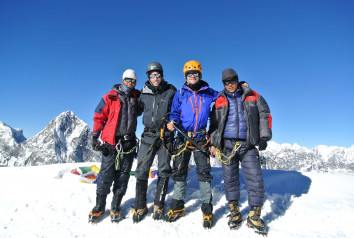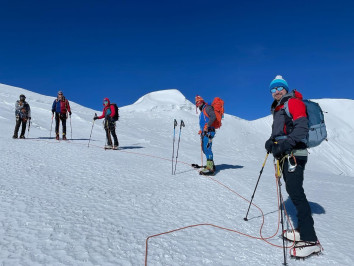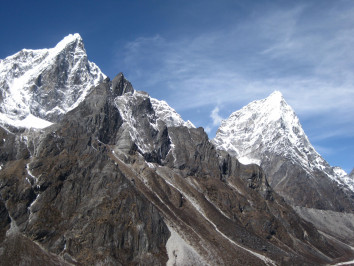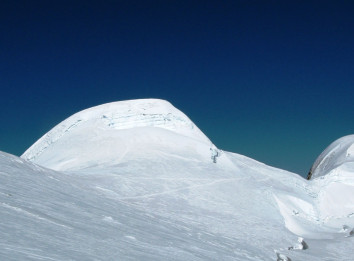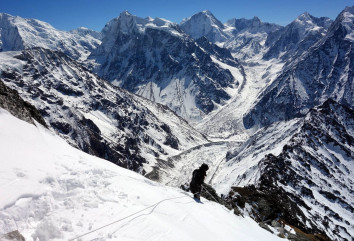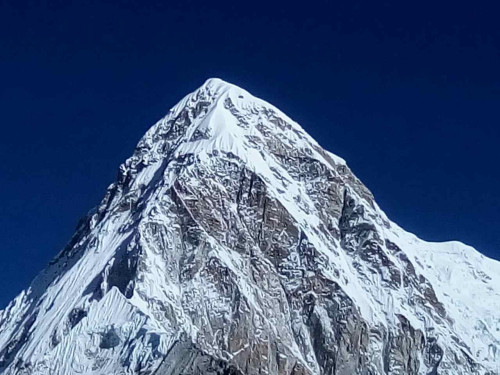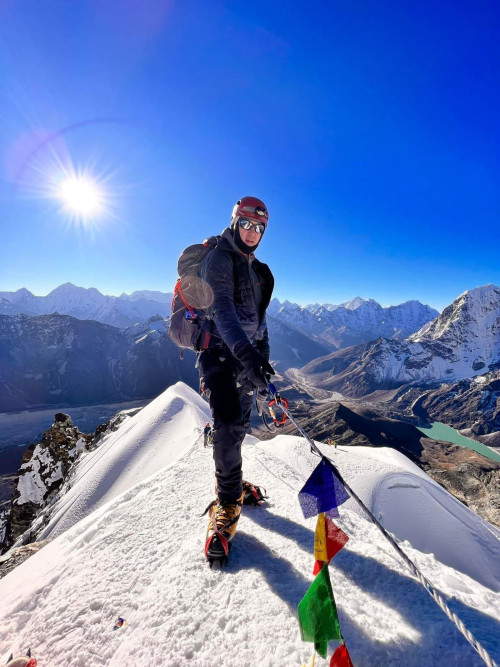Dhampus Peak Climbing - Trip Highlights
- Moderate grade Dhampus Peak climbing is best for intermediate and beginner climbers.
- 100% success Dhampus Peak at 6,012 metres summit with our experienced Sherpa guides.
- Crossing a high pass of Dhaulagiri Circuit Route, Thapa Pass at 5,244 metres.
- Supplemental oxygen and one reserve day for acclimatisation or potential bad weather.
- Alluring sightseeing of Dhaulagiri at 8,163 metres, Tukuche Peak at 6,920 metres, Nilgiri at 6,940 metres, Tilicho Peak at 7,134 metres, etc.
- Trekking on Dhaulagiri Circuit, between Upper Dolpo and Mustang valley on either side.
- Easier summit climb compared to Ama Dablam, Island Peak, Mera Peak, and other 6,000 metres trekking peaks.
- Trekking through the diverse topography of Annapurna Conservation Area including Poon Hill, Marpha, Tatopani, etc.
Dhampus Peak Climbing - Trip Overview
Travellers, without a second thought, claim that Annapurna Sanctuary is a heaven of mountains and natural aesthetics. Annapurna Circuit and Dhaulagiri Circuit trek most picked expedition packages by trekkers. Most make it to the base camp, while some trekkers push further to peak climbing for extra thrill and experience. One of such best picks is Dhampus Peak Climbing. Just at 6,012 metres, this peak is popular among beginner mountaineers and trekkers.
Dhampus Peak, often considered Thapa Peak, sits amid Mt. Dhaulagiri at 8,167 metres and Mt. Annapurna at 8,091 metres. This peak sits on the borderline between Upper Mustang and Upper Dolpo, both jewels of the Himalayas.
Those who trek Dhaulagiri Circuit find climbing Dhampus Peak an ideal extension of the trip in the Annapurna region. Moderate grade climbing and less technical aspects of this peak lure hundreds of aspiring climbers. Also, summiting Dhampus Peak is comfortable among the 6000 metres trekking peak.
Another reason Dhampus Peak climbing is popular among trekkers and climbers is its time duration. Unlike other 6000 metres peak climbing in the Annapurna region, the Dhampus Peak climbing expedition offers a short itinerary of two weeks. Thus, for trekkers who don't have much travel time but want to pursue peak climbing, the Dhampus Peak expedition becomes the best fit. Here, we’ll present the three week long Dhampus Peak climbing expedition itinerary.
Dhampus Peak, in the centre of the Annapurna region, gives a panoramic view of nearly 30 mountains and peaks in this region. The rewarding climb to the summit awards glimpses of 8000'ers, 7000'ers, and 6000'ers metres peak. Also, countless glaciers and natural springs persist throughout Dhaulagiri Circuit.
From the top, you'll get glimpses of Annapurna, Tukuche at 6,920 metres, Dhaulagiri at 8,167 metres, Thorong Peak at 5,416 metres, Nilgiri, etc.
Tangu Peak at 6,197 metres, Tilicho Peak at 6,920 metres, Puth Hiunchuli at 7,246 metres, and several other peaks are visible from the Dhampus Peak summit. Also, on the west to this summit, you could see landscapes of the Upper Mustang. Further, some glimpses of Upper Dolpo terrain are also visible from the summit of Dhampus Peak.
Dhampus Peak Climbing - Itinerary Overview
The two-week-long Dhampus Peak climbing expedition begins with a drive to Pokhara from Kathmandu. We'll further drive to Naya Pul by private jeep and start our trek from there. We'll continue walking to Muri, Bagar, Sallagari, Italian Base Camp, Dhaulagiri Base Camp, French Col, and hike to Hidden Valley. The off-beat trail from Hidden valley to Dhampus Peak base camp is a serene landscape of the Annapurna region.
Throughout the hiking, we'll walk past luring landscapes. Hike from Muri, Bagar, and Sallagari gives us the touch of village lifestyle. The terrace farming, lush green forests, and cultural diversity of the Gurung community are joyous. The diverse flora and fauna of Annapurna Sanctuary give you the close prospect of Himalayan wildlife. There may be a situation where we may encounter Deers, Blue Sheep, Red Panda, and Pheasants.
We keep ascending with the inspiring view of Kali Gandaki Gorge as a backdrop. The glimpses of snow-filled Dhaulagiri south and Annapurna range start appearing as we hike further to Italian Base Camp and Dhaulagiri Base Camp.
We'll acclimatise at Italian Base Camp before heading to Dhaulagiri Base Camp via Japanese Base Camp. We leave French Col, at 5,360 metres, the highest point of this trekking, to Dhampus Peak Base Camp at 5,100 metres.
We'll reach the base camp on the 10th day of our trip. Here, we'll stay in a tented style for at least three days. After acclimatising and training for climbing, we'll hike to High Camp at 5,600 metres and summit push at 6,012 metres. After a successful summit, we'll hike down to the base camp overnight.
From Dhampus Peak base camp, we'll hike to Dhampus La Pass at 5,250 metres and trek to Yak Kharka, Jomsom, and fly back to Pokhara.
Champs Peak Climbing - Travel Insurance
Travel insurance is a must for the Dhampus Peak expedition. We'll be hiking to Dhampus Peak and its summit above 5,000 metres and 6,000 metres. We'll try our best to arrange proper rest and acclimatisation while ascending to Dhampus Peak Base Camp. Also, there’ll be one buffer day for rest or potential bad weather. But, there's a chance that you'll get altitude sickness. In the worst case, you may need helicopter evacuation.
Thus, travel insurance covers most of your medical treatments if you need one. Paying for helicopter costs will be expensive for you. While buying proper travel insurance will pay all hospitalisation and helicopter bills. This will reduce the burden of cost on you.
Thus, we recommend you buy smart travel insurance.
Dhampus Peak Climbing - Difficulty
Dhampus Peak is the best peak for aspiring climbers. The difficulty in climbing this peak is moderate grade. The summit ridge climb will be somehow strenuous. For the rest of the summit climb, no technical expertise is essential. Physical fitness must be on top because of the long trekking days and hike duration of the Dhampus Peak expedition. Our Sherpa climbing guides will assist you throughout the climb. You'll get constant observation from our climbing team.
Best time for Dhampus Peak Climbing
Spring months like March, April, and May are ideal for Dhampus Peak Climbing. Also, the best time in the Autumn months is best for this expedition.
The trekking to Dhaulagiri Base Camp, prominent parts of Annapurna Sanctuary, and the mountains look spectacular on a clear day. Also, the stable temperature of post and pre-monsoon is best for Dhampus Peak Climbing.
Why World Expedition Nepal for Dhampus Peak Climbing?
World Expedition Nepal focuses on and promotes peak climbing and expeditions in Nepal. We have been providing tour services since 2017 by registered and licensed under Nepal Government. In the Annapurna Base Camp region, we'll make sure that you'll have complete joy alongside the adventure of high-altitude climbing.
Our professional and experienced guides will ensure your utmost comfort and safety on Dhampus Peak climbing. We'll make this tour an unforgettable experience for you. Also, the health and safety of our clients is our primary motto. Our guides for these expeditions have mountain skills certification. They come with expertise in mountain medicine, first aid, and rescue operations.

 Recommended On
Recommended On
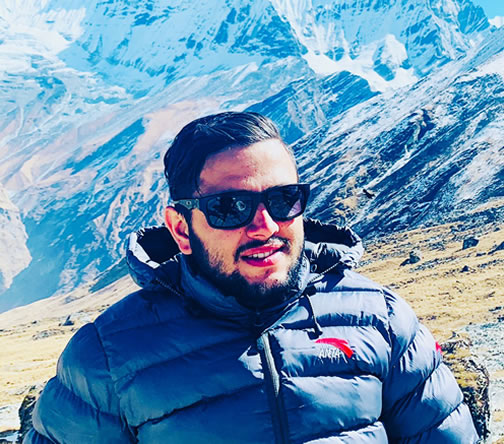


 Price Per Person
Price Per Person
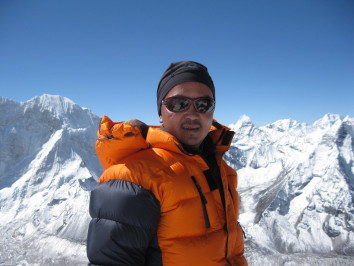
 6000m Peak Climbing , Nepal
6000m Peak Climbing , Nepal  29 Days
29 Days  US$3400
US$3400



-1.JPG)
